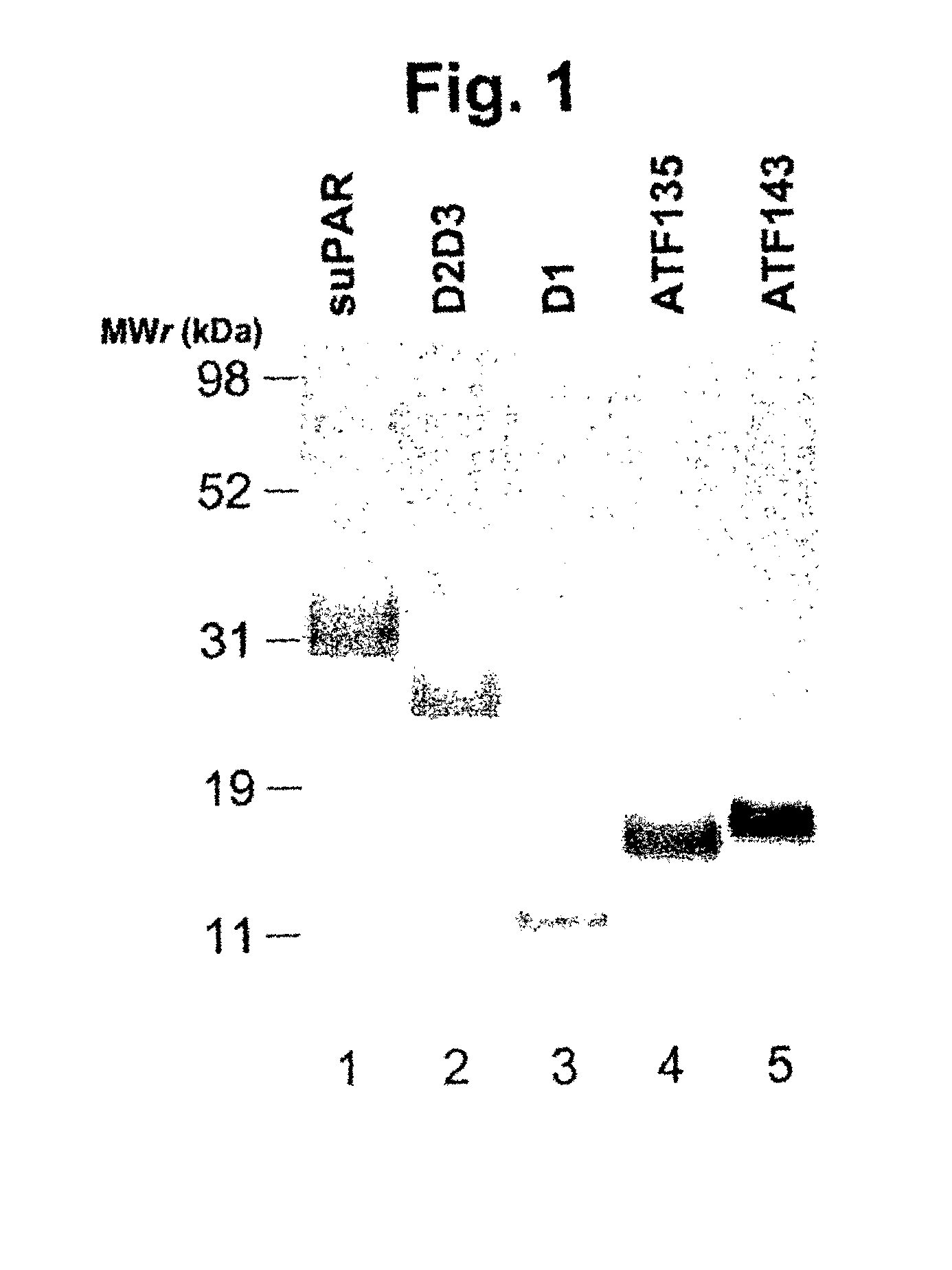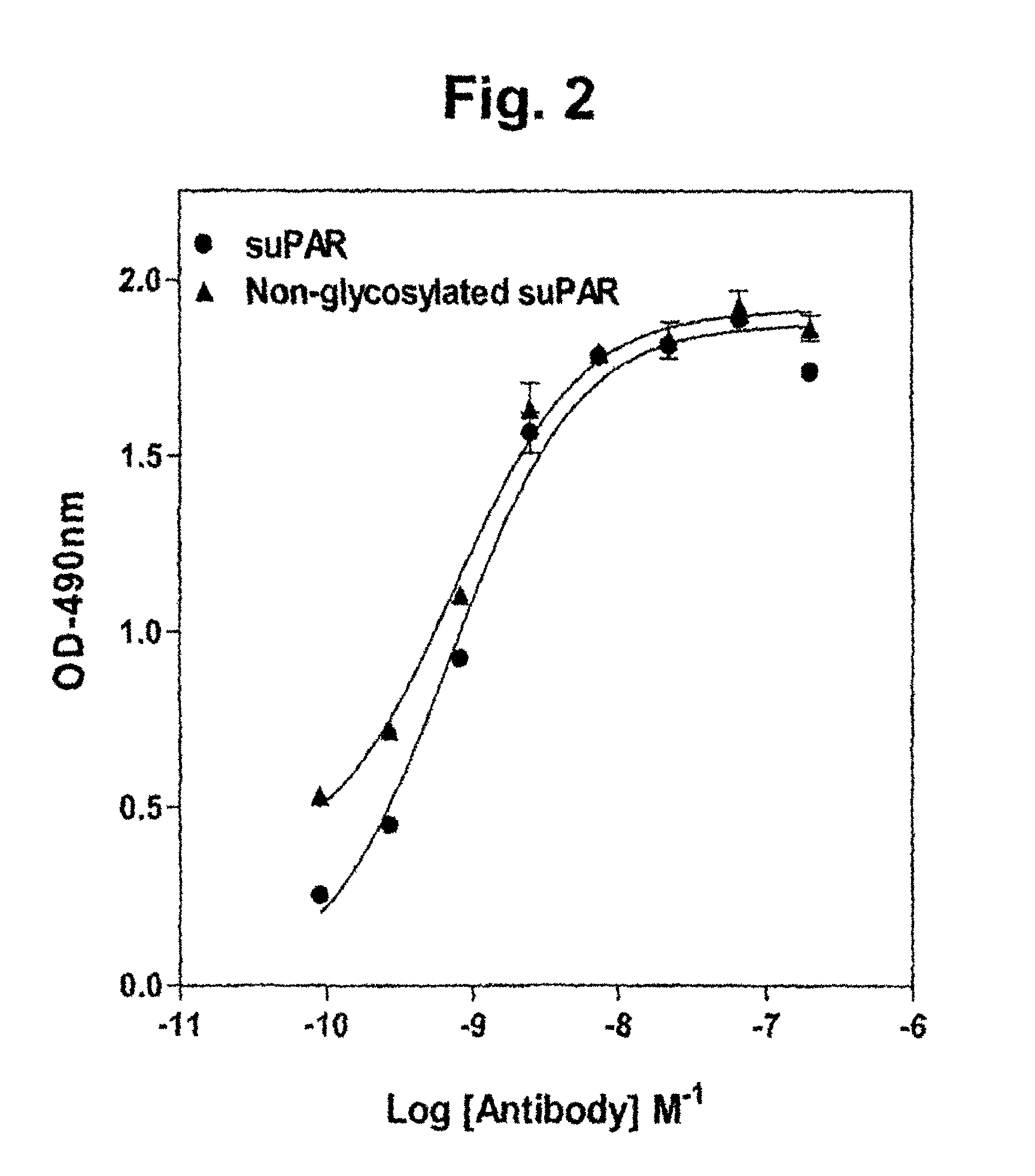Ligands binding the complex of urokinase-type plasminogen activator (uPA) and its receptor (uPAR) that inhibit downstream uPAR interactions: identification and use in diagnosis or therapy
a plasminogen activator and downstream upar technology, applied in the field of biochemistry, immunology and medicine, can solve the problems of tumor regression, hampered small molecule approaches, and not achieving the development of agents suitable for the clinic, and achieve the effect of not inhibiting the binding of upa and upar
- Summary
- Abstract
- Description
- Claims
- Application Information
AI Technical Summary
Benefits of technology
Problems solved by technology
Method used
Image
Examples
example i
Materials and Methods
Cell Lines Expressing Proteins
[0269]The Drosophila expression system (DES™; Invitrogen, Inc.) utilizes the Schneider 2 (S2) cell line, derived from Drosophila melanogaster, and plasmid vectors for the expression of heterologous proteins. The plasmid vectors for expression in S2 cells are very versatile, allowing inducible expression of a protein driven by the metallothionein (MT) promoter. The same plasmid also allows the protein to be secreted from the cell into the surrounding media, greatly simplifying protein purification. Multiple copies of the vector can be stably inserted into the genomic DNA of S2 cells, increasing levels of protein expression. Proteins expressed in S2 cells are minimally glycosylated, which is important for the generation of Abs directed against the protein component of uPAR. Typical yields of protein following purification are 25-50 mg / L with a purity of approximately 95 percent (FIG. 1). Cell lines expressing the following proteins ha...
example ii
Anti-D2D3 mAbs
[0274]Immunization of Balb / c mice with the D2D3 domain of recombinant suPAR conjugated to KLH generated a robust immune response. Subsequent fusion experiments generated parental clones with specific cross-reactivity with the D2D3 domain of uPAR as determined by western blotting and ELISA assays using recombinant proteins. These parental clones were subjected to limiting dilution and a panel of mAbs specific for D2D3 was obtained. The properties of four of these Abs are summarized in Table 3. Isotyping identified all clones as IgG1, κ. Specificity for uPAR was confirmed by western blotting. The affinity of the Abs was determined using direct binding assays. The majority of clones have affinities of 1 to 5 nM.
[0275]
TABLE 3Anti-D2D3 (uPAR) antibodiesWestern BlotClone #Isotype(suPAR)KD (nM)ATN-615IgG1, κ+2ATN-658IgG1, κ+1ATN-616IgG1, κ+5ATN-617IgG1, κ+3
[0276]The results of Western blotting experiments using two of these Abs, ATN-615 and ATN-658, are shown in FIG. 3. Both ...
example iii
Binding of uPA to uPAR
[0281]Binding of uPA to uPAR was measured using 125I-labeled uPA and HeLa cells. HeLa cells express abundant amounts of uPAR but do not express uPA. Briefly, 100 μg of scuPA was labeled with 100 μCi of [125I]NaI using IodoGen™ iodination reagent (Pierce Biotechnology Inc.). Unincorporated labeled NaI was removed from the labeled protein using a size exclusion column and the labeled protein eluted in Tris-buffered saline containing 0.1% bovine serum albumin (BSA). HeLa cells were incubated with increasing concentrations of [125I]-scuPA diluted in PBS containing 0.1% BSA for 2 h at 4° C. Cells were washed extensively with PBS / 0.1% BSA, the cell monolayers lysed with 1M NaOH and the total number of bound counts determined. Specific binding was determined by incubating cells with [125I]-scuPA in the presence of a large excess of unlabeled scuPA. Binding was also performed with MDA-MB231 cells which express both uPA and uPAR. To determine binding of scuPA, endogenou...
PUM
| Property | Measurement | Unit |
|---|---|---|
| molecular mass | aaaaa | aaaaa |
| molecular mass | aaaaa | aaaaa |
| pH | aaaaa | aaaaa |
Abstract
Description
Claims
Application Information
 Login to View More
Login to View More - R&D
- Intellectual Property
- Life Sciences
- Materials
- Tech Scout
- Unparalleled Data Quality
- Higher Quality Content
- 60% Fewer Hallucinations
Browse by: Latest US Patents, China's latest patents, Technical Efficacy Thesaurus, Application Domain, Technology Topic, Popular Technical Reports.
© 2025 PatSnap. All rights reserved.Legal|Privacy policy|Modern Slavery Act Transparency Statement|Sitemap|About US| Contact US: help@patsnap.com



